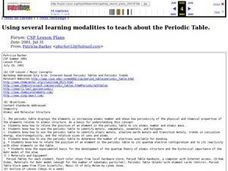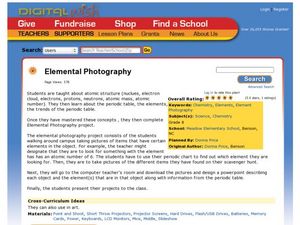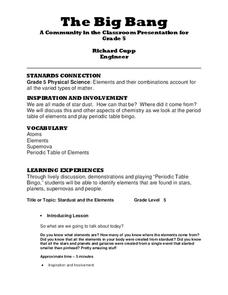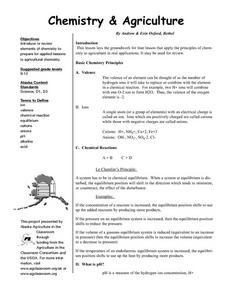Curated OER
Chocolatium
Students find the average atomic mass of M & M's. In this chemistry lesson, students are given a sample of the element chocolatium and the atomic mass of each sample. They then find the average atomic mass.
Curated OER
The Elements
Fifth graders explore the differences between elements. In this elements and atoms lesson students complete an activity that shows how chemicals react to a flame test.
Curated OER
Periodic Properties Lab
Students investigate the periodic properties of elements in the periodic table. For this periodic properties lesson plan, students experiment with elements from the Alkaline Earth Metals, the Halogens, the Transition Metals, and for...
Curated OER
Organization of the Elements and Periodic Table
Students identify how to relate the position of an element in the periodic table to its atomic number and atomic mass. They also identify and interpret how to use the periodic table to identify metals, semimetals, nonmetals, and...
Curated OER
Using several learning modalities to teach about the Periodic Table.
Students identify how to relate the position of an element in the periodic table to its atomic number and atomic mass. They identify how to use the periodic table to identify metals, semimetals, nonmetals, and halogens, and also,...
Curated OER
Periodic Table & Its Trends-Day 1
Students are introduced to the periodic table. They find the common trends among the electron configurations and the names of certain groups of the table. Students explore the atomic mass, atomic number, mass number, mass and charge...
Curated OER
Metals, Non-Metals, Metalloids
Learners describe properties of various elements. They arrange the elements based on properties in order to explain the organization of the periodic table. They label elements as metal, non-metal, or metalloid.
National Museum of Nuclear Science & History
Alphas, Betas and Gammas Oh, My!
Referring to the periodic table of elements, nuclear physics learners determine the resulting elements of alpha and beta decay. Answers are given in atomic notation, showing the atomic symbol, mass, atomic number, and emission particles....
NASA
Connecting Models and Critical Questions
Scholars use data to analyze and determine which sets of information need to be counted. They create a model to explain differences among chemical elements using graphs to prove concept mastery.
NASA
Development of a Model: Analyzing Elemental Abundance
How do scientists identify which elements originate from meteorites? Scholars learn about a sample of material found in a remote location, analyzing the sample to determine if it might be from Earth or not. They study elements, isotopes,...
Virginia Department of Education
Elements and Electron Configuration
It's electronic! Pupils uncover elements and their electron configurations as they explore mass, groupings, correct charges, and sliding theory. Young scientists learn creative ways to remember various elements and correctly classify...
Curated OER
Chemistry Review
In this chemistry review worksheet, students identify chemical changes, isotopes, ions, and chemical bonds. This worksheet has 32 multiple choice questions.
Curated OER
Elemental Photography
Eighth graders investigate objects for a specific element from the Periodic Table. In this elemental photography lesson, 8th graders observe for and object and photograph it. Students use photographs to prepare a multimedia...
Curated OER
The Big Bang
Fifth graders relate the elements in the human body to those produced during a supernova. In this space science and chemistry lesson, 5th graders listen to a lecture and view visuals about the big bang. They relate the production of...
Curated OER
Properties of Elements
Eighth graders explore information about the periodic table of elements. Using the Internet, 8th graders choose one element to research. They complete an "Adopt and Element" information sheet. Using Microsoft Word, students create an...
Curated OER
Matter: Build a Word
Fourth graders examine matter and the periodic table of elements. In this matter lesson, 4th graders discuss atoms and their composition. Students explore the periodic table of elements and use it to spell words out of the elements.
Curated OER
Basic Chemistry Principles
High schoolers use the basic principles of Chemistry to determine pH levels. Elements of the Periodic Table are also included in this lesson.
Curated OER
Periodic Table & Its Trends
Students review atomic structure and then participate in a activity in which they categorize several "elements" into some form of order based on their properties. They discuss the trends they see. They also practice several electron...
Curated OER
Understanding Oxidation Numbers
Students review atomic numbers, positive and negative charges, and the periodic table. They examine the relationships among protons and electrons, location of various elements, electron energy levels, and oxidation numbers.
Curated OER
Mass, Mole, Volume Conversions
In this conversion worksheet, pupils make the following conversions, showing each step. Students use the periodic table and express all molar masses to 1 decimal place.
Curated OER
Metals or Nonmetals? The Families of Elements
Fourth graders, in groups, compile information on groups of elements. They study Alkali Metals, Alkaline Earth Metals, Halogens, and Noble Gases.
Curated OER
Kalzium
Students explore an interactive program about the periodic table. They use the Kalzium software to dynamically explore the relationships between elements, the periodic table and properties of the elements.
Curated OER
How Can You Tell One Clear Gas From Another?
Fifth graders perform experiments to determine the identity of an unknown gas sample. In this chemistry lesson, 5th graders fill balloons with air, oxygen, hydrogen, and carbon dioxide. They use mass and reactivity to identify the gases.
Curated OER
Chemical Formulas
Here is an interesting lesson which invites learners to focus on understanding and interpreting the symbols used in writing and communicating information about chemical elements, compounds, and equations. The hope is that this knowledge...

























